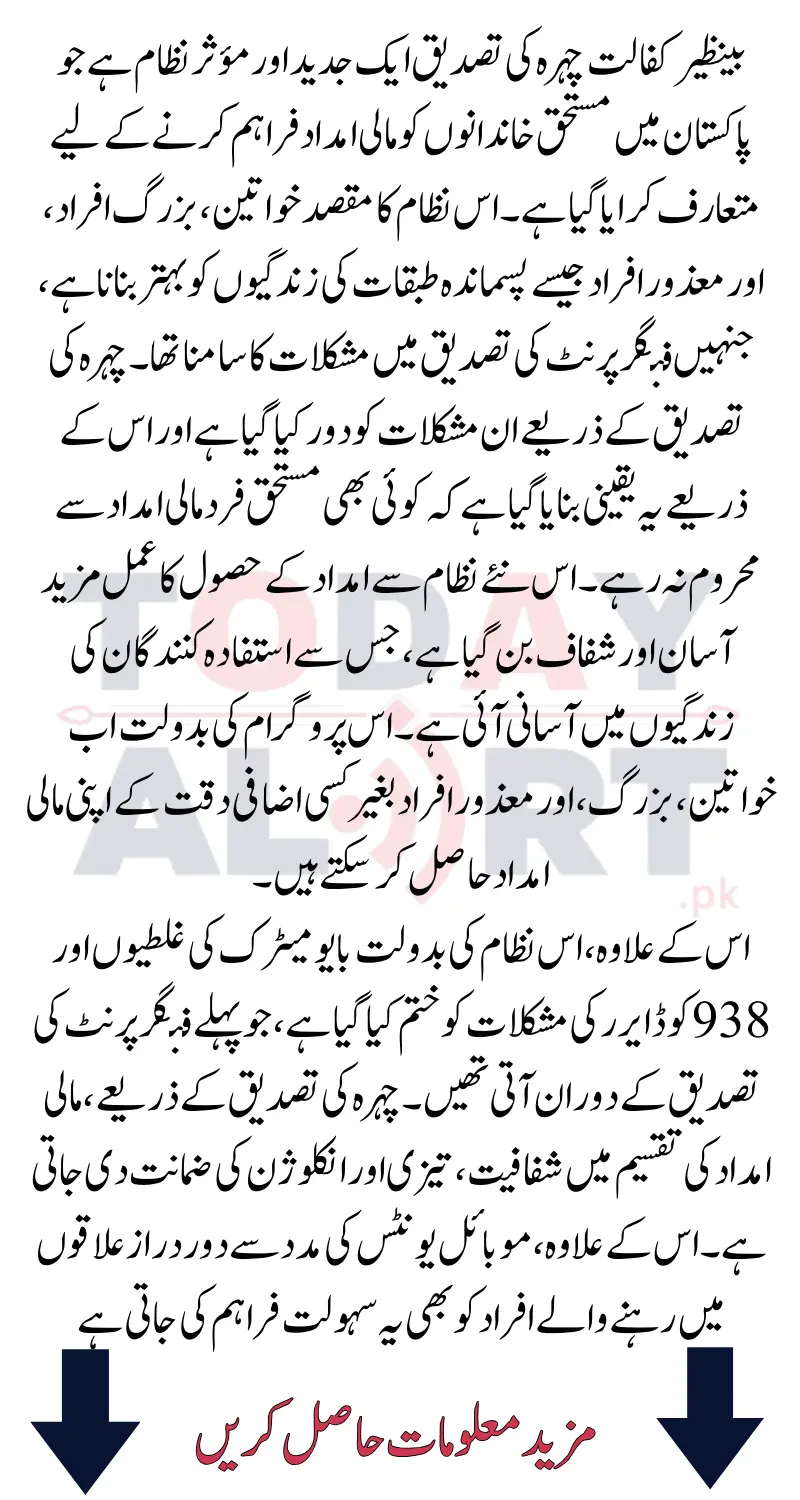The Benazir Kafalat Face Verification is a vital initiative aimed at providing financial assistance to underprivileged families in Pakistan. Among the most important components of BISP is the Benazir Kafalat Face Verification, which supports women, particularly those in need. The introduction of face verification for beneficiaries of the program is a significant step forward.
Addressing the challenges many face when trying to access their financial assistance. This new system is set to change how beneficiaries access their payments, making the process smoother and more inclusive for all. In this article, we will explore why Benazir Kafalat face verification is important for beneficiaries and how it will impact the distribution of the latest payment of Rs. 13,500.
Benazir Kafalat Face Verification Process
Benazir Kafalat Face Verification is a new, revolutionary system that replaces the old fingerprint verification process with facial recognition technology. Traditional fingerprint verification often presented difficulties for many beneficiaries, especially elderly individuals and those with unreadable or faded fingerprints. This could be due to age, physical labor, or medical conditions that caused their fingerprints to fade, making it hard to authenticate their identity and claim financial assistance.
With the new face verification system, individuals whose fingerprints are unreadable can now verify their identity using their faces. This ensures that they can access their financial assistance without facing unnecessary delays or complications. This system is especially beneficial for women, the elderly, and persons with disabilities who previously faced barriers to receiving their payments.

Why is Face Verification Necessary for Benazir Kafalat?
Overcoming Fingerprint Challenges
Fingerprint verification was a core component of the Benazir Kafalat program, but it came with several issues that caused frustration for many beneficiaries. One major issue was the fading of fingerprints, especially for elderly individuals or women who worked with their hands, such as farmers or housewives. Fingerprints could become unreadable over time due to physical labor or age, failing verification.
Another problem was the biometrics mismatch, where outdated or incorrectly registered biometric data led to the rejection of a person’s verification request. This led to delays and repeated visits to the BISP office, causing further inconvenience.
Read more: Benazir Kafalat New Stipend 13500 Documents Re-Verification Process Explained
With face verification, all these problems are eliminated. The system uses modern facial recognition technology to verify the identity of beneficiaries, ensuring that no one is left behind due to fingerprint issues. The face verification system simplifies and speeds up the process, making the distribution of financial aid more efficient and accessible.
Making Financial Aid Accessible for Everyone
The main goal of the Benazir Kafalat face verification system is to ensure that every deserving individual has easy access to financial assistance. Women, elderly individuals, and persons with disabilities are often the most vulnerable and have the most difficulty with fingerprint verification. Now, they will no longer face the hassle of having their thumbprints verified; instead, they can use their faces to prove their identity and receive the aid they need.
Moreover, the face verification system offers a faster, more reliable, and inclusive solution for beneficiaries. It eliminates the need for repeated visits to BISP offices, saving time and effort for everyone involved. In rural and underserved areas, mobile units will even bring the face verification service directly to beneficiaries, ensuring no one is left behind.
Read more: Who Can Receive the BISP 13500 Payment After Check Eligibility Details in 2025
Benefits of Benazir Kafalat Face Verification
The introduction of face verification brings numerous benefits to the beneficiaries of the Benazir Kafalat program. Here are some of the key advantages of the new system:
1. Accessibility for All Beneficiaries
The face verification system allows all eligible individuals to verify their identity easily, regardless of their fingerprint condition. This system is especially beneficial for those with unreadable or faded fingerprints, ensuring that everyone can access their financial assistance.
Also read: Double Payment 13500 Verification Process for BISP Kafalat Beneficiaries
2. Faster Payments
With the traditional fingerprint verification system, many beneficiaries experienced delays in receiving their payments. These delays were often due to fingerprint mismatches or outdated biometric data. With the new face verification system, payments will be processed much faster, as facial recognition technology is more accurate and efficient.
3. Convenience and Time-Saving
The face verification process eliminates the need for repeated visits to BISP offices. Beneficiaries can now complete their verification quickly and easily, saving them time and effort. In addition, the system is available in mobile units, which travel to remote areas, ensuring that beneficiaries in underserved regions also benefit from this new system.
Also read: All Information About BISP 13500 Payment Notifications and Updates
4. Inclusivity
The face verification system ensures that no deserving individual is left out due to technical difficulties or challenges in fingerprint verification. The system is designed to accommodate individuals from all walks of life, regardless of their physical conditions.
5. Transparency
Face verification enhances the reliability and transparency of the financial aid distribution process. With fewer errors and delays, the process becomes more transparent, building trust in the system and ensuring that financial assistance reaches those who need it most.
Read more: BISP Payment 2025 Collection Process – Payment Amount and Payment Centers Details
How Does the Face Verification Process Work?
The process of verifying one identity using face recognition is easy to follow. Here is a step-by-step guide for beneficiaries:
- Visit a Verification Point: Beneficiaries need to visit the nearest BISP office or a mobile verification unit.
- Capture Facial Data: The staff will use facial recognition technology to capture the individual’s facial features.
- Verify Your Identity: The facial data will be matched with the existing information in the BISP database to verify the beneficiary’s identity.
- Payment Collection: Once verification is successful, beneficiaries will be able to collect their payment through ATMs, BISP cash points, or mobile units.
This process ensures that beneficiaries can receive their payments without any unnecessary hassle, and they can rest assured that their identity is verified securely and efficiently.
Resolving the 938 Code Error
One of the most common issues faced by beneficiaries in the past was the 938 code error, which typically occurred due to mismatched thumbprints or outdated biometric data. Many women, particularly those with worn-out fingerprints, faced this issue repeatedly. However, with the introduction of face verification, the 938 code error can now be resolved quickly and efficiently.
By using facial recognition technology, beneficiaries can now bypass the 938 code error and receive their payments without further complications. This change will significantly improve the experience for those who previously struggled with fingerprint verification.
Read more: BISP January 2025 Payment Increase – How to Check New Amount and Collect Your Payment
Eligibility Criteria for the Latest Payment of Rs. 13,500
To qualify for the latest installment of Rs. 13,500, beneficiaries must meet the following criteria:
- A household poverty score below 32, as determined by the National Socio-Economic Registry (NSER).
- Priority is given to disabled individuals, widows, and low-income families.
- Beneficiaries must ensure that their CNIC and biometric data are accurate and up-to-date in the BISP database.
- The monthly household income must not exceed Rs. 60,000.
These criteria ensure that the financial assistance reaches the individuals and families who need it the most.
Payment Collection Methods
Once verified through the face verification system, beneficiaries can collect their payments in several ways:
ATM Withdrawal: Payments can be withdrawn from ATMs using the beneficiary’s bank account.
BISP Cash Points: Designated cash points are available for those who do not have access to a bank.
Mobile Units: For individuals in remote areas, mobile verification units provide on-site services for payment collection.
This variety of payment options ensures that beneficiaries can easily access their assistance, regardless of their location or banking situation.
The Role of Mobile Units in Face Verification
Mobile units play a crucial role in ensuring that beneficiaries, especially those in remote and underserved areas, can access the face verification system. These mobile units travel to various regions and provide on-site face verification and payment collection services. By bringing the service directly to the beneficiaries, mobile units ensure that everyone has the opportunity to participate in the program and receive their financial aid.
Read more: Benazir Taleemi Wazaif January 2025 Payment Status: Check Your Eligibility Now
Conclusion
The introduction of the Benazir Kafalat Face Verification system marks a significant step in the evolution of Pakistan’s financial assistance programs. It addresses many of the challenges faced by beneficiaries, particularly those with unreadable fingerprints or biometric mismatches. By using facial recognition technology, the system ensures that all deserving individuals can access their financial assistance quickly and easily, without unnecessary delays or complications.
This innovative solution will benefit thousands of women, the elderly, and persons with disabilities, ensuring that they receive the support they need. With faster payments, fewer office visits, and increased inclusivity, the Benazir Kafalat Face Verification system is set to transform the way financial assistance is distributed in Pakistan, bringing relief to the most vulnerable populations
